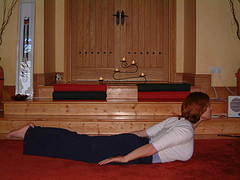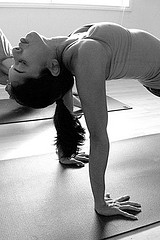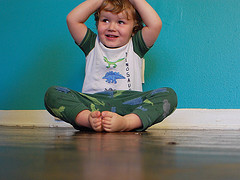asanas
Displaying 1 - 35 of 35 » page 1 of 1
Journal Post
In Yoga, shoulder stand is known as the queen of all asanas while headstand is the king of all asanas. Thus, subtly suggesting that headstand is superior to shoulder stand
But we all know that behind every powerful king there is an even more powerful queen…J
The question remains: is headstand stand actually ‘better’ or more powerful than shoulder stand?
We REALLY want to know. What do YOU want?
April feels like the culmination of a great deal of work on many levels. We have made it through a long, challenging Winter where we spent time downsizing and taking inventory of what is working and what is not. We have made some hard decisions and have let go of what is no longer serving us. With the return of Spring is the Return of Hope. , the spiritual quality of the spring in Traditional Chinese Medicine.
We are so grateful for your support!
iHanuman is going through many changes as we work to bring our updated media platform online. We look forward to unveiling our new site and all of the great content you have been waiting for. We just wanted to take a moment to say thank you to all of you who have supported us over the years. We are a small company with BIG ideas and we look forward to sharing some big news withyou over the coming weeks. We have also had many requests for more classes from John Schumacher. His latest classes will be available next month, so stay tuned for an update.
When I first began teaching yoga in 1981, yoga wasn't exactly entrenched in the mainstream as it is now. I had been meditating for four years and doing asana out of a book daily. There was never a thought about becoming a yoga teacher, as I had four children, ages 7-14, and it was all I could do to stay afloat and meet my commitments as an Air Force wife and mother. My daily meditation practice helped more than anything else to keep me on a fairly even keel during those challenging days.
Explore the pros and cons of hands-on guidance and learn to use skillful assists to empower
your students.
By Sara Avant Stover
"Come on! Extend, Karl! Don't be so stingy!" exclaimed Sharon Gannon, cofounder of Jivamukti Yoga, to student Karl Straub, as she assisted him in Ardha Chandrasana (Half Moon Pose). Straub, a Jivamukti Yoga teacher himself, as well as a Thai Yoga Bodywork practitioner, recalls the potency of Gannon's assist-one that he revisits every time he practices that
your students.
By Sara Avant Stover
"Come on! Extend, Karl! Don't be so stingy!" exclaimed Sharon Gannon, cofounder of Jivamukti Yoga, to student Karl Straub, as she assisted him in Ardha Chandrasana (Half Moon Pose). Straub, a Jivamukti Yoga teacher himself, as well as a Thai Yoga Bodywork practitioner, recalls the potency of Gannon's assist-one that he revisits every time he practices that
My original intention for this month was to write about one of the pioneers of modern yoga, Shri Yogendra. But just this morning I received a newsletter from a yoga school-here unnamed-where I found a short essay, "About Yoga," that begins with: "Yoga is an ancient science practiced for thousands of years." Friends, as Joan Rivers says, can we talk? Let's start with "thousands of years." The Sanskrit word sanatva means "ancientness," it's an idea that's found everywhere in Hinduism.
I reviewed my first video for Yoga Journal in 1991, and since then I've reviewed at least a couple in every single issue for the last 18 years. Just this year I reviewed my 300th video (though I've probably watched at least half again as many that didn't pass muster), and by some strange alignment of planets or more likely some cosmic comedy of karmas, it was a presentation by our very own Rod Yee.
After a month's hiatus, we return to the story of Yoga in the US. In the July newsletter we looked at one of the unsung female Yoga pioneers of the 20th century, Sita Devi Yogendra, and I promised you then more about our female trail blazers. So this month we'll visit with a woman whose life spanned the entire 20th century, and whose followers lovingly called her the "First Lady of Yoga."
I'm just back from my third annual Yoga workshop in Hailey, Idaho. When I asked the folks up in Hailey what they wanted to work on this year they set me an interesting task: a weekend workshop based on poses named after Hindu gods. After digging through Iyengar's Light on Yoga (200 asanas), Yogeshvara Paramahamsa's First Steps to Higher Yoga (300 asanas), and the Lonavla Institute's Encyclopedia of Traditional Asanas (900 asanas), I decided to open things up and include in the workshop poses named after Hindu sages and one famous monster. And so we had a Virabhadra Class (the hideous demon created by Shiva to punish his father-in-law), a Sages Class, an Avatars of Vishnu Class, and a Shiva Nataraja Class.
I have no shame admitting that I tend to get a little carried away every now and then. Let's be honest, I wouldn't be the Capricious Yogi if I didn't! In fact, with all the recent transition and activity swirling around me, it's a wonder that I'm not floating amongst the clouds for eternity. I've been up and down and all around. Without yoga and a grounding practice, I can only imagine how much more off kilter I'd be. Grounding. It's that feeling of stepping on my mat, finding my seat, connecting all four corners of my feet that ultimately rejuvenates me. It's the moments when I can take off my shoes and walk barefoot or feel the warm sand between my toes.
Do you ever find yourself holding on so tightly to a desired outcome that you are a filled with anxiety, tension or blind ambition? Have you ever wanted to do a yoga posture so badly so that you are literally obsessing about it and can talk of almost nothing else? This is perhaps the definition of unhealthy attachment at its core. Yet at the same time the driven mind directed at a task at hand is one of the most powerful tools we have to change our lives. So the question then becomes not how to rid ourselves of our desires or our drive but instead how to train our mind to work towards our desires without the unnecessary tension of attachment.
A couple of newsletters back I wrote about how the Unity Woods logo came into being and what my thinking was in creating it, and the significance of the various components. As there wasn't space then to talk about the three words that appear at the points of the triangle, I said I would do so in subsequent newsletters. In the last newsletter, I discussed the relevance of the first of the three words: health. Now we come to the second: serenity.
For over 40 years, legendary and humble yoga Master Sri Dharma Mittra has been promoting a live food diet to students around the world.
A Disciple of Sri Swami Kailashananda, Dharma Mittra has spent his life in service to humanity, and has been personally responsible for the advancement of healthy living through a live diet as taught to him by his own Guru, Yogi Gupta.
From his days in the Ashram, preparing live food and juices for the Guru and Ashram residents, to his earliest days in the 1970’s as a celebrated teacher in NYC, sprouting almonds and juicing vegetables and fruits for his students, this saintly Yogi has been living and spreading the knowledge of a live diet long before it gained the popularity of today.
Most people know yoga as a physical exercise system that increases flexibility and teaches them how to relax. However, yoga is a comprehensive discipline that encompasses principles for living in the world and practices to deepen spiritual life, in addition to achieving physical well-being. Yoga is a nourishing practice on all levels!
John is featured in the Yoga Journal Asana Column
When it came to the fitness benefits yoga can or can't provide, yoga teacher John Schumacher had heard it all. A student of B. K. S. Iyengar for 20 years and founder of the Unity Woods studios in the Washington, D.C. area, Schumacher was convinced yoga provides a complete fitness regime. But many people, even some of his own students, disagreed. Yoga might be good for flexibility or relaxation, they'd say, but to be truly fit, you had to combine it with an activity like running or weight lifting.
Schumacher just didn't buy it.
When it came to the fitness benefits yoga can or can't provide, yoga teacher John Schumacher had heard it all. A student of B. K. S. Iyengar for 20 years and founder of the Unity Woods studios in the Washington, D.C. area, Schumacher was convinced yoga provides a complete fitness regime. But many people, even some of his own students, disagreed. Yoga might be good for flexibility or relaxation, they'd say, but to be truly fit, you had to combine it with an activity like running or weight lifting.
Schumacher just didn't buy it.
If you need some inspiration to reinvigorate your daily yoga practice, September is a great month to start.
I don't typically write reviews for these letters-in fact I've never written one here before-but I have a new book hot off the press that needs and deserves all the hype it can get. Last Fall I was fortunate enough to be invited to a yoga conference at Cavallo Point, just on the Marin side of the Golden Gate Bridge, a beautiful spot (with a great restaurant) if you're ever looking for a retreat location. The gathering was billed as "An Opportunity to Consider an Authentic Voice for Yoga Today" three days of talks on topics like the relationship between yoga and buddhism, yoga and art, and yoga and tantra ... well, what did you expect yoga people to talk about when they get together?
Like many Sanskrit words in the Yoga lexicon, the word guru has both a literal and symbolic meaning. Literally it means "heavy, weighty; heavy in the stomach (as food), difficult to digest; excessive, difficult, hard; important, serious, momentous; valuable, highly prized; venerable, respectable." The guru is the venerable "weighty one," heavy with wisdom, that's both highly prized but at times difficult to digest, often because teaching seems to contradict everything we hold true, or because we're told things about ourselves we don't especially want to hear.
People who have never practiced yoga before often ask me to teach them a yoga pose. The Iyengar student in me cannot help but start by teaching Tadasana. People are often astounded by how much integrity and poise there is when conscious attention is brought to the simple act standing. They are amazed at how much attention can be brought to the four corners of the feet, the inner line of the legs, the lift of the knee caps and the release of the tailbone. Once we build the foundation. we move to the upper body and take a deep inhale to engage the abdomen, lift the sternum and lift and roll the shoulders back.
Supta Virasana, or Reclining Hero's Pose, is practiced by first situating yourself into Virasana, Hero's Pose. This pose can be very difficult on the knees, so take it easy. If you are unable to sit completely between your heels, as in the picture to the left, then sit on a yoga block or a blanket. You want to be sure that there is NO pain in the inner or outer knees. Take a few breaths here to settle into the pose and add props as needed.
Although some are talking about another 40 inches of snow this month, March is the month of the spring equinox and therefore heralds the beginning of spring. Until then, we are still in the water element and the end of the winter.
We are surprised to find, or not find rather, Vrschikasana, Scorpion Pose, listed among the backbends or the arm balances on the Yoga Journal List of Poses. As we wind down our backbends as we approach the spring equinox, we would be remiss in not including this challenging backbend among our poses.
There is no one pose that is the most feminine pose. Some poses are more feminine than others and some poses make you feel more feminine on different days of your practice. Ardha Chandrasana, Half Moon Pose, always feels very feminine to me. Perhaps it is because when I practice it on a good day, I feel extremely graceful and elegant. And while the name, camel pose, may not sound very feminine, Ustrasana, is very uplifting and powerful.
For any yogi who has a favorite friend of the canine variety, you cannot help but smile when they practice upward or downward dog. Urdhva Mukha Svanasana, or upward facing dog, is another in our series of backward bending poses which is also clearly an arm and wrist strengthening pose. Poses such as Bhujangasana, Cobra Pose or Setu Bandha Sarvangasana, Bridge Pose, are excellent preparatory poses for Upward Facing Dog pose.
Bhekasana or Frog Pose is another challenging backbend which requires strength not only in the back but also in the arms and flexibility in the shoulders. Bhekasana is best practiced after warming up with standing poses or other preparatory backbends.
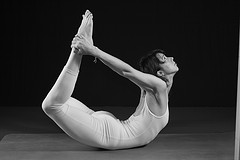 Dhanurasana, or Bow Pose, is a fantastic back-bending pose for opening the chest and shoulders and strengthening the back. This pose is challenging as it reminds how important the legs are in back-bending poses. In addition to the strength in the back required for backbends, there is even more strength required in the legs, particularly the quadriceps.
Dhanurasana, or Bow Pose, is a fantastic back-bending pose for opening the chest and shoulders and strengthening the back. This pose is challenging as it reminds how important the legs are in back-bending poses. In addition to the strength in the back required for backbends, there is even more strength required in the legs, particularly the quadriceps.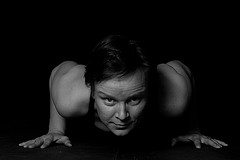 Chaturanga Dandasana or the Four-Limbed Staff Pose is also called Plank Position. Chaturanga Dandasana is itself not described as a backbend but is often used to prepare for backbends because it strengthens the spinal muscles. Plank pose is the infamous Yoga Push Up which is one of the sequence of asanas in Surya Namaskar or Sun Salutations.
Chaturanga Dandasana or the Four-Limbed Staff Pose is also called Plank Position. Chaturanga Dandasana is itself not described as a backbend but is often used to prepare for backbends because it strengthens the spinal muscles. Plank pose is the infamous Yoga Push Up which is one of the sequence of asanas in Surya Namaskar or Sun Salutations. Open the heart and stretch the belly with Bhujangasana or Cobra Pose. Back bends stimulate the Kidney Energy and invigorate the heart. Back bends can counteract the effects of depression. During the winter, many people experience Seasonal Affective Disorder, SAD, because of the decrease in light. Back bends, when practiced correctly, elevate our mood. This gentle back bend improves digestion and creates flexibility in the spine.
Open the heart and stretch the belly with Bhujangasana or Cobra Pose. Back bends stimulate the Kidney Energy and invigorate the heart. Back bends can counteract the effects of depression. During the winter, many people experience Seasonal Affective Disorder, SAD, because of the decrease in light. Back bends, when practiced correctly, elevate our mood. This gentle back bend improves digestion and creates flexibility in the spine.It is wintertime. One of the best seasons to practice yoga simply because it is an excellent indoor activity. In the chinese tradition, wintertime is a time to focus on balancing the Kidney Energy (Qi). One way to access the Kidney Qi is to practice backbends. And since it is February, it is also nice to focus on poses that open the heart. One of the myriad backbending asanas to choose from is Matsyasana or Lord of the Fishes pose. Yoga Journal has a good description for practicing Matsyasana. Unfortunately, I was unable to find a good video description of this pose, so we will just have to create one...
At the end of February we left off with one foot in the door of the Hatha Yoga Pradipika, one of the oldest surviving Hatha Yoga manuals. Hatha Yoga emerged sometime in the 9th or 10th centuries CE, strongly influenced by both Hindu Tantra and Indian alchemy. The Pradipika was written four or five hundred years later, though remnants of these ancient disciplines are still evident in this text and others like it. The Gheranda Samhita for example, a companion text that's a few hundred years younger, calls Hatha Yoga the "Yoga of the Pot" (ghata yoga), "pot" here referring to the human body (or more precisely the torso) which is compared to an alchemical vessel.
Traditional Hatha Yoga, as it's described in the school's oldest surviving instruction manuals, is an odd-looking duck, at least to our modern Western eyes. Take the granddaddy of these books, Svatmarama Yogendra's Hatha Yoga Pradipika (literally "Light on the Forceful Union-Method"), which is a venerable 600 years old, possibly older. It consists of 389 verses divided into four chapters on asana, pranayama, mudra ("seals") and bandha ("bonds"), and samadhi or enstasis. We moderns might expect the longest chapter would be on asana. And why not?
Are you a Yoga Teacher?
Are you a Yoga Student?
Do you Own a Yoga Studio?

